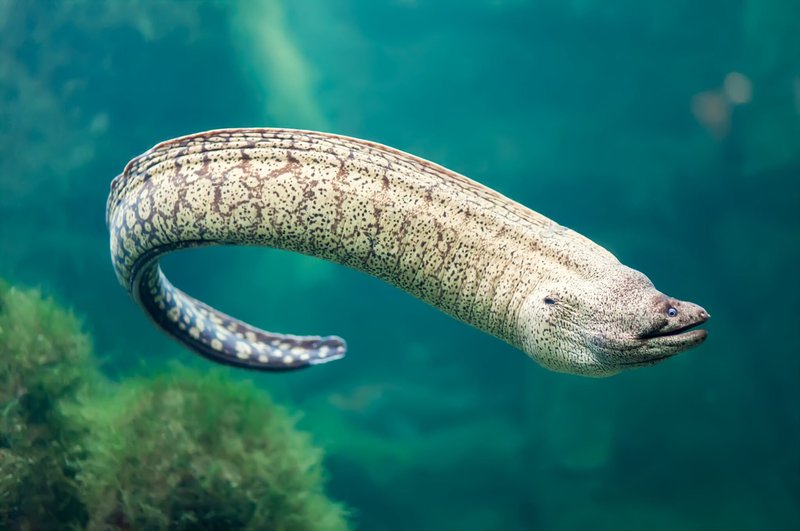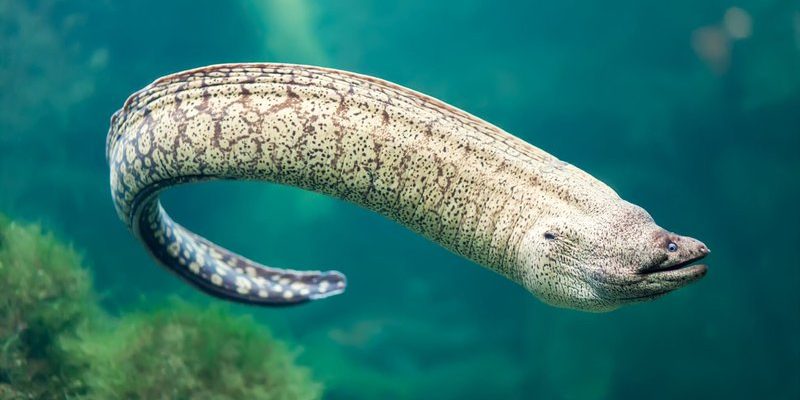
Picture this: you’re diving in a vibrant coral reef, surrounded by colorful fish and swaying sea plants. Suddenly, a sleek, snake-like creature peeks out from a rocky crevice, its curious eyes watching you intently. That’s a Moray Eel, one of the ocean’s most intriguing residents. These eels are not just fascinating because of their unique appearance; they have a rich history and a vital role in marine ecosystems.
Moray eels belong to the family Muraenidae and are known for their elongated bodies and lack of pelvic fins, which set them apart from other types of eels. They can be found in warm coastal waters across the globe, especially in tropical and subtropical areas. With over 200 species identified, these eels come in various colors and patterns, making them a favorite for divers and marine enthusiasts alike. Let’s dive deeper into the life of these fascinating creatures.
Physical Characteristics of Moray Eels
Moray eels can grow quite large, with some species reaching lengths of up to ten feet or more! Their bodies are long and muscular, nearly resembling a snake’s. You might wonder how these eels are so agile in the water. This agility comes from their flexible, elongated bodies, which allow them to maneuver easily through tight spaces in their rocky habitats. The skin of a Moray eel is usually covered in a layer of mucus, which helps protect them from parasites and injury.
The color of these eels varies significantly across different species. For instance, the green moray eel has a vibrant greenish-brown hue, while the giant moray can be a striking combination of browns and yellows. This diverse array of colors serves a crucial purpose: it helps them blend into their environment, making it easier for them to ambush prey or hide from predators. This natural camouflage is one of the reasons why they’re such effective hunters.
Habitat and Distribution
You can find Moray eels nestled in rocky crevices and coral reefs in warm ocean waters. They’re primarily distributed in the Indo-Pacific regions, including the Caribbean Sea, the Red Sea, and the Gulf of Mexico. Morays prefer shallow waters where they can easily find hiding spots and hunt for food. The nooks and crannies of reefs provide the perfect habitat for them to dwell and hunt.
These eels are often solitary creatures, although some species may be more social than others. They tend to be more active at night, engaging in what scientists call “nocturnal hunting.” During the day, Moray eels like to stay hidden in their burrows, partially sticking out to survey their surroundings. This behavior adds to their mystique and makes encounters with these creatures all the more thrilling!
Diet and Feeding Habits
Moray eels are carnivorous, which means they primarily eat meat. Their diet mainly consists of fish, crustaceans, and mollusks. With their keen sense of smell, they can detect prey from a distance. When hunting, a Moray eel will use its well-developed jaws and sharp teeth to catch and hold onto slippery fish. They are known to strike quickly and often, showcasing their impressive agility.
You might think that with their sharp teeth, Moray eels are dangerous. While they can deliver a painful bite if threatened, they are not aggressive towards humans unless provoked. However, it’s essential to remember to give them space and respect their territory. When it comes to feeding, Moray eels are quite resourceful; they can wait patiently for hours to ambush their prey, making every meal an adventure.
Reproduction and Life Cycle
The reproductive habits of Moray eels are quite fascinating and still not fully understood. Most species are believed to spawn in open waters, where the female releases eggs that are fertilized by the male. This process usually occurs during warmer months, although it can vary by species. Once the eggs hatch, the young eels, called leptocephali, drift in the ocean currents for several months before settling into their habitats.
As they grow, juvenile Moray eels undergo a metamorphosis, changing from flat, leaf-like bodies to the elongated shape we associate with adult eels. This transition allows them to adapt better to their new environments. Typically, Moray eels can live for several years, with some species reaching lifespans of up to 30 years in the wild. This longevity is yet another reason these creatures hold a special place in the hearts of marine enthusiasts.
Conservation and Threats
While Moray eels are fascinating creatures, they face some significant threats in their natural habitats. Overfishing, habitat destruction due to coastal development, and pollution are among the primary challenges these eels encounter. Many species of Moray eels are also targeted for the seafood trade, which has led to declines in local populations.
Conservation efforts are crucial to protect Moray eels and their ecosystems. Several organizations work to raise awareness about the importance of preserving coral reefs and maintaining healthy ocean environments. By supporting sustainable fishing practices and protecting marine areas, we can help ensure that Moray eels thrive for generations to come.
Moray Eel as a Cultural Icon
In many cultures, Moray eels are viewed with a mix of fascination and fear. They often appear in folklore and stories, sometimes representing danger and mystery. Some communities in the Pacific Islands hold Moray eels in high regard, associating them with good fortune or spiritual significance. This connection to culture makes them more than just a marine animal; they symbolize the intricate relationship humans have with the ocean.
Moray eels have also found their way into popular culture, appearing in documentaries and films that highlight the beauty of marine life. Their unique appearance and behaviors make them a favorite subject for underwater photography, drawing interest from both amateur and professional photographers alike. It’s fascinating how these creatures serve as a bridge between art, science, and culture.
Interesting Facts About Moray Eels
| Average Size: | 3 to 10 feet long |
| Habitat: | Coral reefs and rocky crevices |
| Diet: | Carnivorous (fish, crustaceans) |
| Reproductive Method: | Spawning in open waters |
| Lifespan: | Up to 30 years |
| Species Count: | Over 200 types |
Moray eels are truly remarkable creatures that intrigue marine enthusiasts and casual observers alike. With their unique appearance, fascinating behaviors, and important role in the marine ecosystem, these eels remind us of the wonders of the ocean. As we continue to learn more about them, it’s essential that we also commit to protecting their environments so future generations can enjoy their beauty.
FAQ
Are Moray eels dangerous to humans?
While Moray eels can bite if threatened, they are generally not dangerous to humans. They tend to avoid contact and are more curious than aggressive. Just remember to give them space and observe them from a distance.
What do Moray eels eat?
Moray eels are carnivorous and primarily feed on fish, crustaceans, and other marine animals. Their keen sense of smell and sharp teeth help them effectively hunt their prey in their habitats.
Where do Moray eels live?
You can find Moray eels in warm coastal waters, especially around coral reefs and rocky areas. They prefer shallow water environments where they can hide and hunt for food.
How do Moray eels reproduce?
Most Moray eels spawn in open waters, where females release eggs that males fertilize. The young eels drift as larvae in the ocean currents before settling into their habitats and undergoing metamorphosis.
How long do Moray eels live?
Moray eels can live for several years, with some species reaching lifespans of up to 30 years in the wild. The longevity of these creatures is part of what makes them so fascinating.
Can Moray eels change color?
While Moray eels don’t change color like some other marine animals, their patterns and colors can vary significantly from species to species. This diversity aids in their camouflage within their habitats.
What are the threats facing Moray eels?
Moray eels face several threats, including overfishing, habitat destruction, and pollution. Conservation efforts are crucial to maintaining their populations and the health of marine ecosystems.
Why are Moray eels important to the ecosystem?
Moray eels play a vital role in the marine food web. As predators, they help control the populations of their prey, contributing to the balance of marine ecosystems. Healthy eel populations indicate a thriving ocean environment.
Can Moray eels swim fast?
Moray eels are not particularly fast swimmers. Instead, they rely on their agility and ability to maneuver through rocky crevices. Their body shape allows them to glide smoothly through tight spaces.
Are Moray eels solitary or social?
Moray eels are generally solitary creatures, often found hiding alone in their crevices. However, some species do exhibit more social behaviors and may be seen with other Morays or sharing living spaces.
What role do Moray eels play in human culture?
Moray eels appear in various cultural stories, often symbolizing mystery and danger. In some cultures, they hold spiritual significance, and they are also popular subjects in underwater photography and documentaries.
How can we help protect Moray eels?
Supporting sustainable fishing practices, reducing pollution, and advocating for marine conservation areas are great ways to help protect Moray eels and their habitats. By being mindful of our impact on oceans, we can contribute to their health and longevity.

